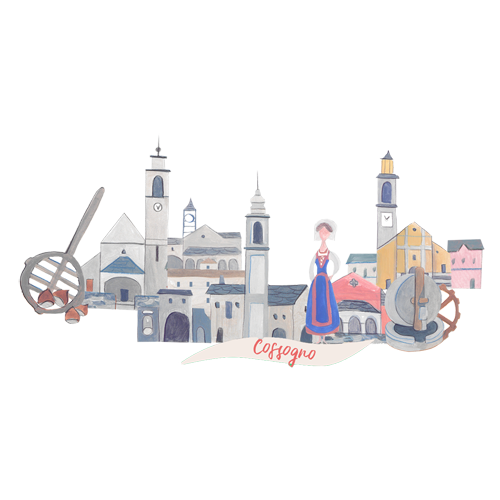I pendii che circondano Cicogna, come gran parte delle Terre di Mezzo, sono conquistati da castagni: alcuni secolari, altri più giovani e che si stanno piano piano impossessando di tutti i terrazzamenti. La castagna è sempre stata alla base dell’economia montana: un albero adulto produceva in una stagione un quantitativo di castagne tale da dare nutrimento ad una persona per tutto l’inverno. Con attrezzi appositi, quali le giuve, pinza in legno, o le spisuche, martello in legno per rompere i ricci, le castagne venivano raccolte e deposte nei cesti, come il cavagn, o nelle gerle. Per essiccarle, si posizionavano poi le castagne sulle gràa, graticci di rami di castagno intrecciati o di assi ravvicinate posti al posto del soffitto in edifici appositi o in una delle stanze delle abitazioni, attraverso i quali passavano il fumo e il calore del focolare (brandanáa) acceso nella stanza sottostante. Le castagne venivano affumicate e disidratate per quasi tre settimane, dopodiché ancora calde venivano battute con le spevige, attrezzo costituito da un disco di legno di noce con un manico, per toglierne la buccia. Nel vall, ventilabro di legno intrecciato, venivano poi scosse per eliminare l’ultima pellicola e ottenere le castagne bianche, in parte vendute o barattate oppure macinate nel mulino di Cossogno.
The slopes surrounding Cicogna, like most of the Midlands, are rich in chestnut trees: some are centuries-old, others are younger and are slowly taking possession of all the terracing hills. Chestnut has always been one of the main activities of the mountain economy: an adult tree produced in one season an amount of chestnuts such as to feed a person throughout the winter. Using special tools, such as the giuve, wooden pliers, or the spisuche, a wooden hammer to break the husks, the chestnuts were collected and placed into baskets, such as the cavagn, or into panniers. To dry them, the chestnuts were placed on the gràa, a latticework of criss-crossed chestnut tree branches or joined axes placed instead of the ceiling in special buildings or in one of the rooms of the houses, through which the smoke and the heat of the hearth (brandanáa) lit in the room below passed. The chestnuts were smoked and dehydrated for almost three weeks, afterwards, when they were still hot, they were beaten with the spevige, a tool consisting of a walnut disk with a handle, to remove the peel. In the vall, a braided wooden winnowing fan, they were shaken to remove the last peel and obtain white chestnuts, partly sold or bartered or ground in the mill of Cossogno.
TI TROVI A
YOU ARE IN
